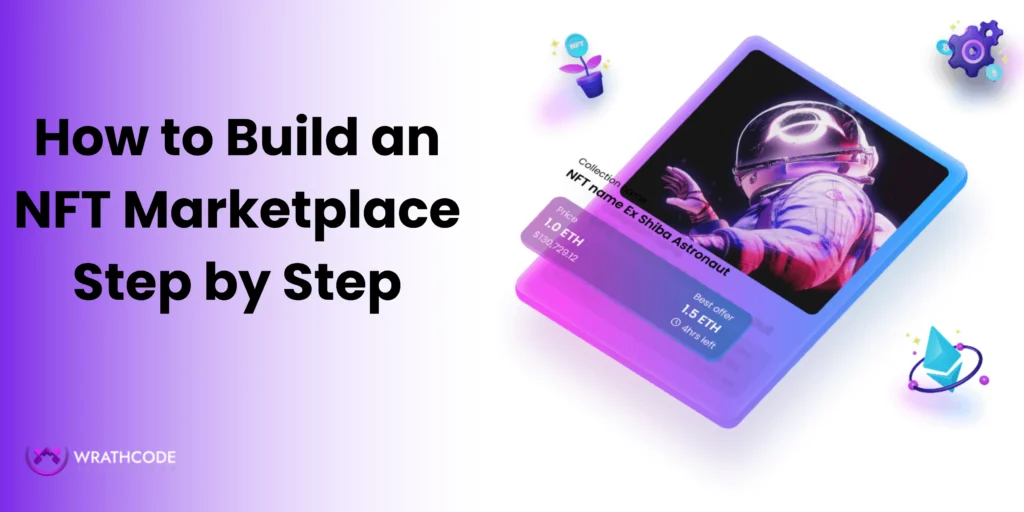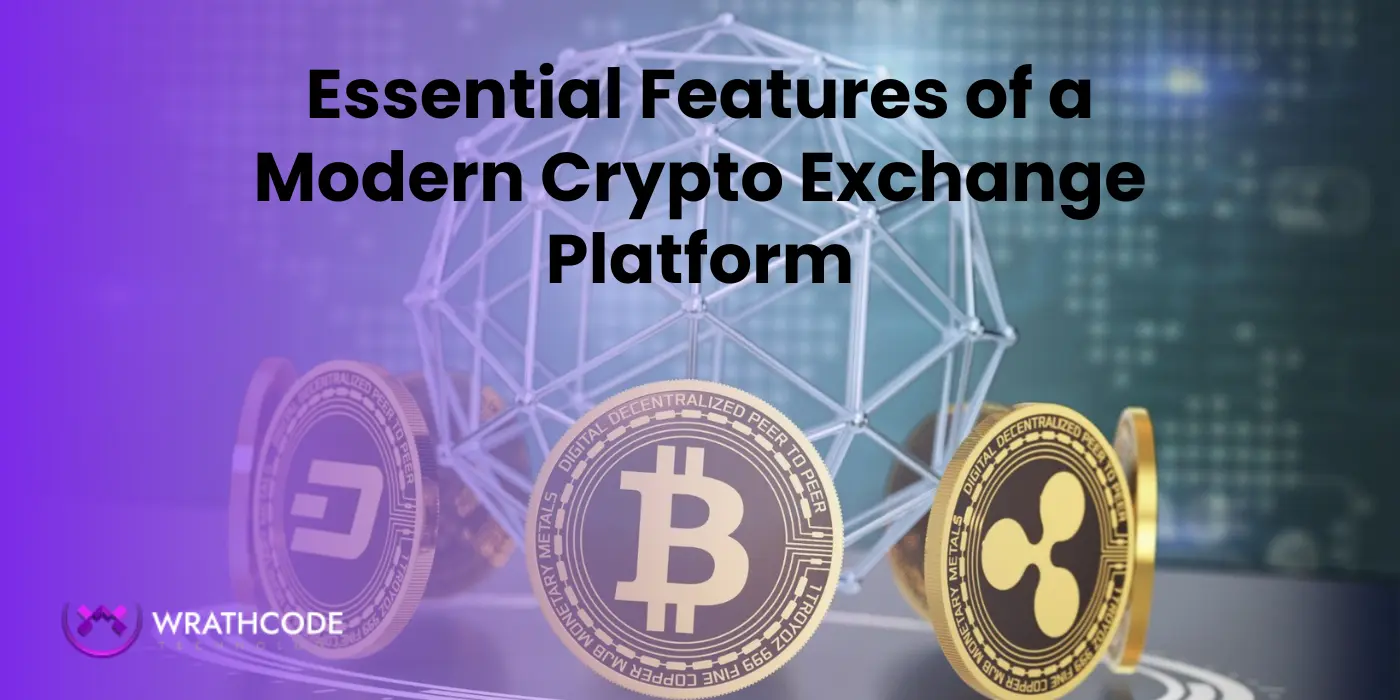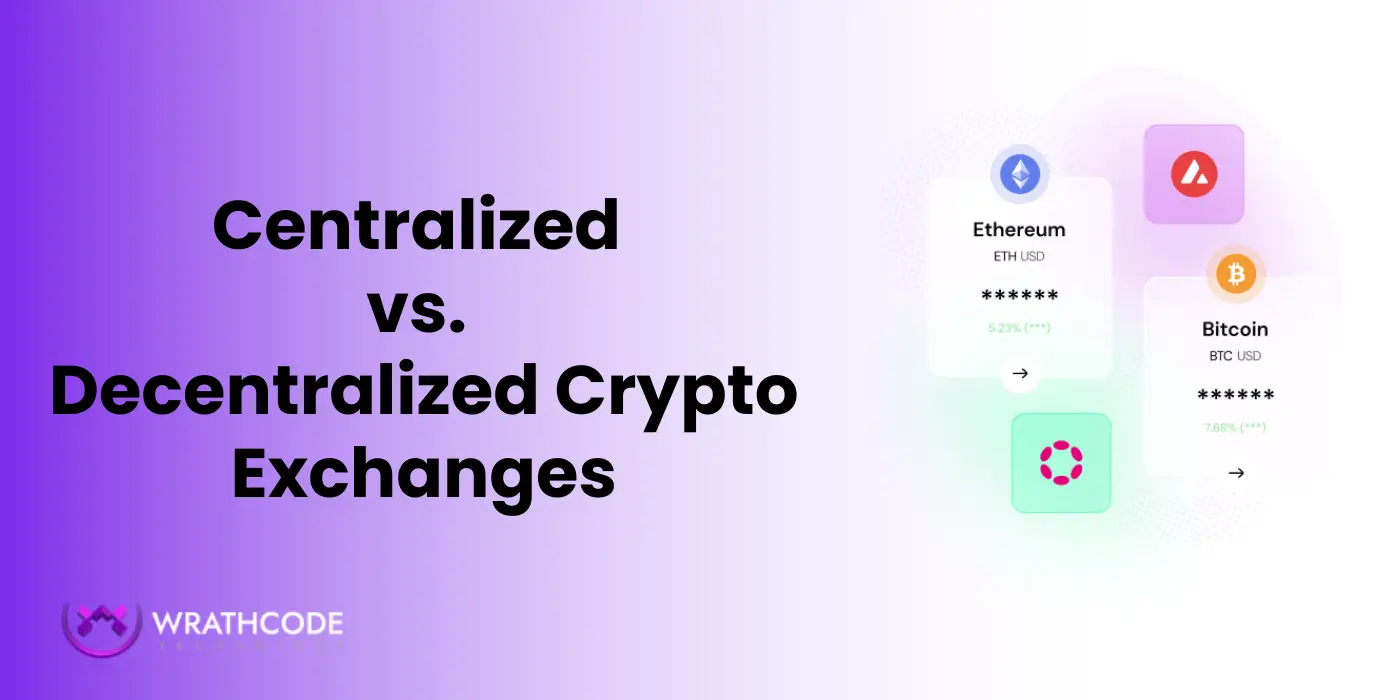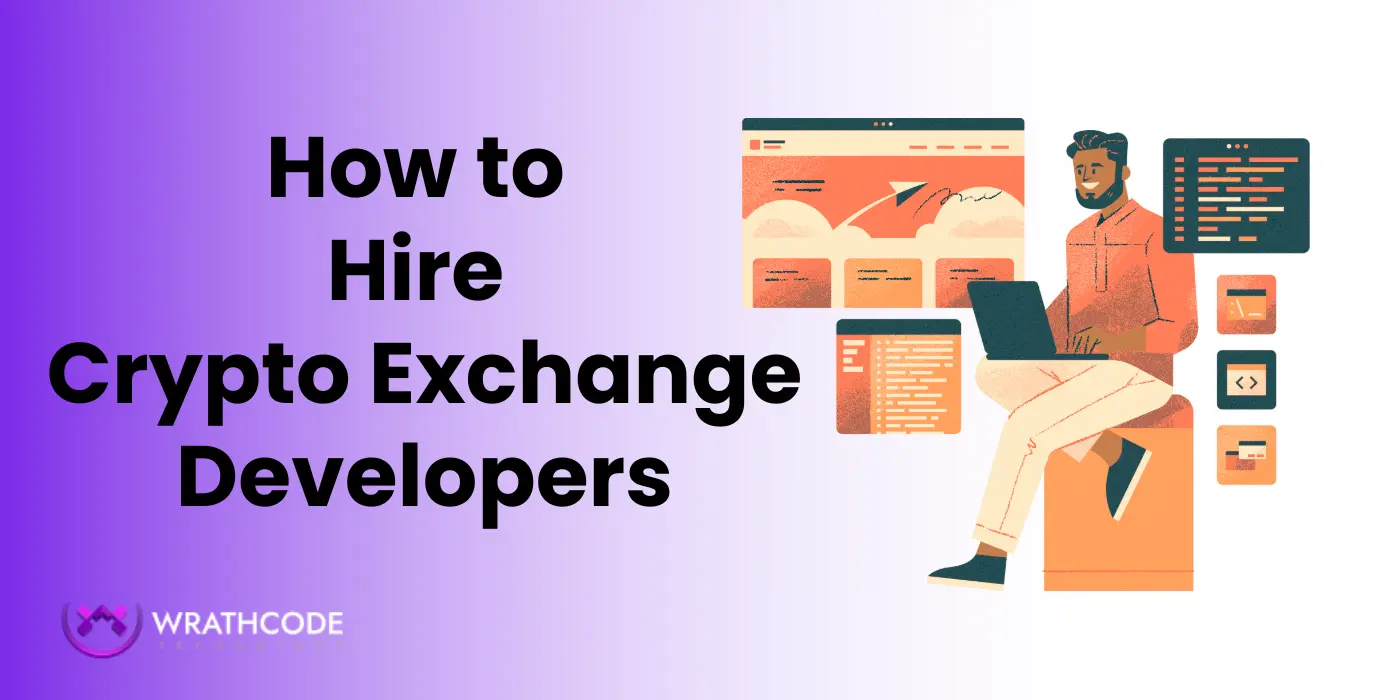
NFTs have moved far beyond digital art. They now power gaming ecosystems, music platforms, real estate tokenization, and brand loyalty programs. According to Grand View Research, the global NFT market is expected to reach USD 211.7 billion by 2030, growing at a CAGR of 34.2%. This rapid expansion has fueled demand for NFT marketplaces that are scalable, secure, and user-friendly.
An NFT marketplace is a platform where users can mint, buy, sell, and trade digital assets recorded on the blockchain. Building such a platform requires careful planning, everything from defining the business model to choosing the right blockchain, designing smart contracts, and ensuring strong security.
This guide breaks the process into clear, actionable steps. It covers the technical foundation, business strategy, and growth considerations needed to launch a marketplace that attracts both creators and collectors.
Define the Purpose & Business Model
Before writing a single line of code, you need clarity on why your NFT marketplace exists and who it serves. Marketplaces built without a clear business direction often fail to gain traction.
1. Identify Your Target Audience
NFT platforms can cater to very different segments:
- Artists & Collectors → Platforms like OpenSea focus on digital art and collectibles.
- Gaming Studios → Marketplaces for in-game assets (skins, weapons, characters).
- Musicians & Creators → Platforms offering royalty distribution and fan engagement.
- Real Estate & Enterprises → Tokenization of property deeds, contracts, or corporate assets.
👉 Each audience has different feature needs. For example, gamers value cross-chain speed, while real estate users demand compliance and security.
2. Choose a Business Model
Your business model defines how the marketplace generates revenue. The most common strategies include:
- Transaction Fees → A percentage charged per sale (OpenSea charges 2.5%).
- Listing Fees → Users pay to list NFTs.
- Premium Subscriptions → Advanced tools or analytics for power users.
- Advertising/Promotions → Featured NFT slots for visibility.
- Royalties → Percentage for creators every time an NFT is resold.
3. Define the Marketplace Type
You’ll need to decide between:
- Niche Marketplaces (focused on a single vertical, e.g., music NFTs).
- General Marketplaces (broad focus, wide user base).
Core Features to Include
An NFT marketplace is more than just a platform to buy and sell tokens. Its features define user experience, scalability, and revenue opportunities. A well-thought-out feature set helps you launch quickly with an MVP (Minimum Viable Product) while leaving room for expansion as the platform grows. Below, we separate the essential features for launch from the advanced ones that help differentiate and scale.
MVP Features (Launch Ready Essentials)
When you’re just starting out, the goal is to deliver a working product fast. These core elements allow users to create, buy, and sell NFTs without friction:
- User Profiles & Authentication → Secure onboarding, either via email or crypto wallet login, with profile pages showing owned NFTs and transaction history.
- NFT Minting Module → A simple way for creators to upload files, add metadata (name, description, properties), and mint NFTs stored on IPFS/Filecoin.
- Wallet Integration → Direct connection with popular wallets like MetaMask and Coinbase Wallet so users can transact without middlemen.
- Storefront & Listings → A catalog-style interface where NFTs are displayed with details such as price, ownership history, and attributes.
- Search & Filtering → Fast and accurate filtering by category, creator, price range, or blockchain to help users find relevant NFTs quickly.
- Buying & Selling (Fixed Price + Auctions) → Basic trading options including direct buy and time-based auctions with transparent transaction records.
These essentials ensure the marketplace can launch as a functional product and start onboarding users immediately.
Advanced Features (Scaling & Differentiation)
Once the marketplace gains traction, advanced features help it stand out in a competitive landscape and retain users long term.
- Royalties & Secondary Sales → Automated royalty distribution every time an NFT is resold, giving creators recurring income.
- Multi-Currency & Cross-Chain Support → Support for ETH, MATIC, SOL, stablecoins, and cross-chain NFT transfers to broaden reach.
- Fractional Ownership → Splitting NFTs into smaller, tradable shares — useful for expensive assets like real estate or rare art.
- KYC & Compliance Tools → Identity verification modules to meet legal standards in industries such as finance and property.
- Analytics Dashboard → Insight tools for both creators (sales, engagement) and admins (revenue, activity monitoring).
- Community & Social Features → Likes, comments, and creator following systems that turn marketplaces into communities, not just trading platforms.
⚡ Marketplaces that add social and analytical tools report up to 42% higher repeat engagement compared to platforms focused only on transactions.
Smart Contract Development & Security
At the heart of every NFT marketplace are smart contracts. These are self-executing programs stored on the blockchain that handle transactions, royalties, and ownership transfers without intermediaries. A poorly written smart contract can expose the marketplace to hacks, lost assets, or legal issues, so building them correctly is critical.
Smart contracts in an NFT marketplace usually cover three main areas: minting NFTs, transferring ownership, and automating royalties for creators. To function securely, they must be carefully developed, tested, and audited before launch.
Key Considerations for Smart Contract Development
- Programming Language Choice → Solidity is used for Ethereum and Polygon, Rust for Solana, and Cadence for Flow. Each blockchain requires its own smart contract approach.
- Custom Logic for Royalties → Smart contracts can be coded to automatically pay creators a fixed percentage whenever an NFT is resold.
- Scalability & Efficiency → Gas-efficient contracts reduce transaction fees, which directly improves user adoption.
- Upgradability → Some marketplaces design contracts with upgrade functions, so features can evolve without replacing the entire system.
Security Best Practices
Security is one of the most critical aspects of NFT marketplace development. In 2024 alone, blockchain security firm CertiK reported over $1.8 billion lost due to smart contract vulnerabilities. To protect both users and the platform, these practices are essential:
- Auditing → Third-party audits ensure contracts are free from vulnerabilities such as reentrancy attacks, integer overflows, or front-running.
- Testnet Deployment → Running contracts on test networks like Goerli (Ethereum) or Devnet (Solana) helps simulate real-world usage before going live.
- Bug Bounty Programs → Incentivizing ethical hackers to find weaknesses builds extra confidence in the platform.
- Multisig Wallets → Using multi-signature admin wallets prevents single points of failure in contract upgrades or fund transfers.
- Monitoring Tools → Continuous on-chain monitoring helps detect suspicious activity early.
Why This Matters
Users only trust a marketplace if their assets and funds are secure. High-profile breaches like the 2022 Ronin Bridge hack have made investors more cautious. By prioritizing strong contract logic and rigorous audits, you not only protect your platform but also build credibility in a market where trust directly impacts adoption.
UI/UX Design
Even the most secure and feature-rich NFT marketplace will struggle if the design feels confusing or outdated. A clean, intuitive UI (User Interface) and smooth UX (User Experience) are what make people stay, explore, and trade. Since NFTs attract both seasoned crypto users and newcomers, the marketplace design must balance simplicity with advanced functionality.
Why UI/UX Matters in NFT Marketplaces
- First Impressions Drive Trust → A confusing interface can instantly turn users away. In fact, studies in 2024 showed 88% of users abandon digital platforms if navigation feels complicated.
- Bridging Web2 and Web3 → Many NFT buyers are still unfamiliar with blockchain wallets. Design plays a major role in making wallet connections, minting, and trading feel approachable.
- Conversion Rates → A smoother experience reduces drop-offs during transactions, directly boosting marketplace revenue.
Key Design Principles
- Minimalistic Navigation → Keep the menu simple: Marketplace, Wallet, Create, and Profile. Too many links can overwhelm users.
- Clear NFT Presentation → Use card-based layouts with high-quality visuals, price tags, creator info, and rarity highlights.
- Onboarding Guides → Step-by-step tutorials or tooltips explaining how to connect a wallet or mint NFTs.
- Mobile-First Design → More than 62% of NFT traffic in 2025 comes from mobile devices, so responsive design is no longer optional.
- Transaction Feedback → Progress bars, confirmations, and alerts during minting or buying make blockchain delays less frustrating.
Real World Examples
- OpenSea → Uses a marketplace-style storefront with powerful filters so users can quickly find trending collections. Their simple search + filter design is a benchmark.
- Blur → Optimized for pro-traders with fast NFT listings, advanced analytics, and bulk-buy features — showing how UI/UX can be built for power users.
- Rarible → Focuses on community features like custom storefronts for creators, highlighting the importance of personalization in design.
Best Practices for Competitive Edge
- Incorporate dark and light modes to match user preferences.
- Use micro-interactions (hover effects, animations) to make browsing NFTs engaging.
- Add social sharing buttons directly on NFT pages to increase visibility outside the platform.
- Provide multilingual support, since global adoption is key in NFT markets.
⚡ Marketplaces that offer personalized dashboards and mobile-optimized designs report up to 30% higher trading activity compared to those that stick with desktop-first layouts.
Backend & Blockchain Integration
Behind every smooth NFT transaction lies a solid backend and reliable blockchain integration. While the frontend handles what users see, the backend ensures that minting, buying, and selling NFTs happens seamlessly. The challenge is balancing decentralization with scalability so the marketplace can handle thousands of transactions without bottlenecks.
Core Responsibilities of the Backend
- User Management → Authentication, profiles, and activity logs stored securely.
- NFT Metadata Handling → Metadata (name, description, attributes) must be stored reliably, often on IPFS or Filecoin, while transaction records live on-chain.
- Payment Gateways → Supporting both crypto and fiat payments requires integration with wallets, exchanges, and possibly third-party APIs.
- Transaction History → Complete and transparent logs of sales, bids, and transfers are crucial for user trust.
- Scalability Tools → Load balancers, caching systems, and microservices architecture help manage heavy trading volumes.
Blockchain Integration
Every NFT marketplace must decide which blockchain (or multiple chains) to support. This choice affects transaction costs, speed, and audience reach.
Most Relevant Blockchains in 2025
- Ethereum Layer 2s (Arbitrum, Optimism, zkSync) → With gas fees reduced up to 90% compared to Ethereum mainnet, these are the go-to for NFT projects targeting high volume.
- Polygon (PoS + zkEVM) → Popular for gaming NFTs and partnerships (e.g., Reddit Avatars). Polygon combines low fees with strong ecosystem support.
- Solana → Offers sub-second transaction speeds and low costs, making it ideal for marketplaces with real-time trading.
- Immutable X → Specializes in gaming and NFT marketplaces with built-in royalty enforcement and zero gas fees for users.
- Flow → Initially built for NBA Top Shot, still relevant for entertainment and sports NFT projects.
- Aptos & Sui (Emerging Players) → Both focus on high throughput using Move language and are gaining traction in 2025.
Key Technical Considerations
- On-Chain vs Off-Chain Storage → Storing NFTs fully on-chain is secure but expensive; hybrid solutions (metadata off-chain, ownership on-chain) balance cost and performance.
- API Integrations → OpenSea’s APIs or Moralis can be used for indexing NFTs, wallet connections, and faster development.
- Cross-Chain Bridges → If supporting multiple blockchains, a secure bridging mechanism is vital to allow NFT transfers across ecosystems.
- Node Infrastructure → Running your own nodes or using providers like Infura/Alchemy ensures uptime and reliability.
Why This Step is Crucial
If backend and blockchain systems are poorly implemented, users face failed transactions, high gas fees, or even asset loss. In NFT marketplaces, reliability equals credibility. With Ethereum scaling solutions and Solana’s performance improvements in 2025, projects now have stronger infrastructure options than ever before.
⚡Multi-chain marketplaces show 38% higher user acquisition rates compared to single-chain platforms, as they attract both Ethereum-native and alternative-chain communities.
Testing & Quality Assurance (QA)
Launching an NFT marketplace without rigorous testing is risky. Even small bugs in smart contracts, wallets, or transaction flows can lead to user frustration or financial loss. Testing ensures the platform is reliable, secure, and ready to handle real-world conditions.
Why Testing Matters
- Smart Contract Risks → Errors here can’t be undone once deployed on-chain.
- High Traffic Scenarios → NFT drops can attract thousands of users in seconds. Without load testing, the platform may crash.
- User Experience → Bugs in wallet connections, checkout flows, or NFT minting can kill trust and adoption.
Testing Areas to Focus On
- Functional Testing → Make sure every feature (minting, listing, buying, auctions) works as expected.
- Performance Testing → Stress test the system with heavy traffic to ensure it scales.
- Security Testing → Check for vulnerabilities in smart contracts, wallets, and APIs.
- Cross-Platform Testing → Verify the site works across devices (desktop, mobile, tablets).
- Usability Testing → Collect feedback from test users to identify confusing flows.
Practical QA Checklist for NFT Marketplaces
✔ Wallet Integration
- Can users connect/disconnect wallets easily (MetaMask, Coinbase, WalletConnect)?
- Do transactions show up correctly in wallet history?
✔ Smart Contracts
- Run test cases on minting, transfers, and royalties.
- Deploy contracts on testnets (Goerli, Mumbai, Solana Devnet).
- Get at least one external security audit before mainnet launch.
✔ Marketplace Features
- Check NFT uploads (image, video, audio) for different file formats.
- Validate auction timers and bidding logic.
- Test filtering/search with large datasets.
✔ Scalability & Performance
- Simulate high traffic NFT drops with 10k+ concurrent users.
- Monitor response times for critical actions (buying/minting).
✔ Payment Systems
- Validate transactions in both crypto and fiat gateways.
- Test failed payments and refunds.
✔ UI/UX
- Run usability tests with non-crypto users to spot confusing steps.
- Verify responsive design across devices and browsers.
✔ Security & Compliance
- Run penetration tests.
- Enable monitoring tools to detect unusual activity.
- Confirm GDPR or region-specific compliance for data storage.
Wrapping Up
Building an NFT marketplace is not a one-time project — it’s an ongoing journey that requires technical expertise, security-first development, and adaptability to industry shifts. Whether it’s enabling fractionalized real estate NFTs, integrating multi-chain functionality, or preparing for AI-driven assets, the marketplace you build today must be ready to scale into tomorrow.
At Wrathcode, we specialize in developing NFT marketplaces that combine performance, security, and forward-looking innovation. If you’re ready to build or scale your NFT marketplace, our team can help you design, develop, and future-proof your platform.




Leave a Reply